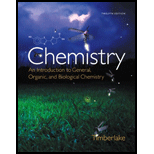
Chemistry: An Introduction to General, Organic, and Biological Chemistry Plus Mastering Chemistry with eText -- Access Card Package (12th Edition)
12th Edition
ISBN: 9780321907141
Author: Karen C. Timberlake
Publisher: PEARSON
expand_more
expand_more
format_list_bulleted
Question
Chapter 17.2, Problem 17.12QAP
Interpretation Introduction
Interpretation:
Find the way in which the ends of
Concept introduction:
A polymer is a long chain mode up of many monomers by covalent bond.
Expert Solution & Answer
Want to see the full answer?
Check out a sample textbook solution
Chapter 17 Solutions
Chemistry: An Introduction to General, Organic, and Biological Chemistry Plus Mastering Chemistry with eText -- Access Card Package (12th Edition)
Ch. 17.1 - Prob. 17.1QAPCh. 17.1 - Prob. 17.2QAPCh. 17.1 - Prob. 17.3QAPCh. 17.1 - Prob. 17.4QAPCh. 17.1 - Prob. 17.5QAPCh. 17.1 - Prob. 17.6QAPCh. 17.1 - Prob. 17.7QAPCh. 17.1 - Prob. 17.8QAPCh. 17.1 - Prob. 17.9QAPCh. 17.1 - Prob. 17.10QAP
Ch. 17.2 - Prob. 17.11QAPCh. 17.2 - Prob. 17.12QAPCh. 17.2 - Prob. 17.13QAPCh. 17.2 - Prob. 17.14QAPCh. 17.3 - Prob. 17.15QAPCh. 17.3 - Prob. 17.16QAPCh. 17.3 - Write the base sequence in a complementary DNA...Ch. 17.3 - Prob. 17.18QAPCh. 17.4 - Prob. 17.19QAPCh. 17.4 - Prob. 17.20QAPCh. 17.4 - Prob. 17.21QAPCh. 17.4 - Prob. 17.22QAPCh. 17.4 - Write the corresponding section of mRNA produced...Ch. 17.4 - Write the corresponding section of mRNA produced...Ch. 17.4 - What is a codon?Ch. 17.4 - Prob. 17.26QAPCh. 17.4 - Prob. 17.27QAPCh. 17.4 - Prob. 17.28QAPCh. 17.4 - Prob. 17.29QAPCh. 17.4 - Prob. 17.30QAPCh. 17.5 - Prob. 17.31QAPCh. 17.5 - Why are there at least 20 different tRNAs?Ch. 17.5 - Prob. 17.33QAPCh. 17.5 - Prob. 17.34QAPCh. 17.5 - Prob. 17.35QAPCh. 17.5 - Prob. 17.36QAPCh. 17.5 - Prob. 17.37QAPCh. 17.5 - Prob. 17.38QAPCh. 17.6 - Prob. 17.39QAPCh. 17.6 - Prob. 17.40QAPCh. 17.6 - Prob. 17.41QAPCh. 17.6 - Prob. 17.42QAPCh. 17.6 - How is protein synthesis affected if the normal...Ch. 17.6 - Prob. 17.44QAPCh. 17.6 - Prob. 17.45QAPCh. 17.6 - Prob. 17.46QAPCh. 17.6 - Prob. 17.47QAPCh. 17.6 - Prob. 17.48QAPCh. 17.7 - Prob. 17.49QAPCh. 17.7 - Prob. 17.50QAPCh. 17.7 - Prob. 17.51QAPCh. 17.7 - Prob. 17.52QAPCh. 17.7 - Prob. 17.53QAPCh. 17.7 - Prob. 17.54QAPCh. 17.7 - Prob. 17.55UTCCh. 17.7 - Suppose a mutation occurs in the DNA section in...Ch. 17.7 - Prob. 17.57AQAPCh. 17.7 - Prob. 17.58AQAPCh. 17.7 - Prob. 17.59AQAPCh. 17.7 - Prob. 17.60AQAPCh. 17.7 - Prob. 17.61AQAPCh. 17.7 - Prob. 17.62AQAPCh. 17.7 - Prob. 17.63AQAPCh. 17.7 - Prob. 17.64AQAPCh. 17.7 - Prob. 17.65AQAPCh. 17.7 - Prob. 17.66AQAPCh. 17.7 - Prob. 17.67AQAPCh. 17.7 - Prob. 17.68AQAPCh. 17.7 - Prob. 17.69AQAPCh. 17.7 - Prob. 17.70AQAPCh. 17.7 - Prob. 17.71AQAPCh. 17.7 - Prob. 17.72AQAPCh. 17.7 - Prob. 17.73AQAPCh. 17.7 - Prob. 17.74AQAPCh. 17.7 - Prob. 17.75AQAPCh. 17.7 - Prob. 17.76AQAPCh. 17 - Prob. 17.77CQCh. 17 - A polypeptide contains 36 amino acids. How many...Ch. 17 - Prob. 17.79CQCh. 17 - Prob. 17.80CQCh. 17 - Prob. 17.81CQCh. 17 - Prob. 17.82CQ
Knowledge Booster
Recommended textbooks for you
 ChemistryChemistryISBN:9781305957404Author:Steven S. Zumdahl, Susan A. Zumdahl, Donald J. DeCostePublisher:Cengage Learning
ChemistryChemistryISBN:9781305957404Author:Steven S. Zumdahl, Susan A. Zumdahl, Donald J. DeCostePublisher:Cengage Learning ChemistryChemistryISBN:9781259911156Author:Raymond Chang Dr., Jason Overby ProfessorPublisher:McGraw-Hill Education
ChemistryChemistryISBN:9781259911156Author:Raymond Chang Dr., Jason Overby ProfessorPublisher:McGraw-Hill Education Principles of Instrumental AnalysisChemistryISBN:9781305577213Author:Douglas A. Skoog, F. James Holler, Stanley R. CrouchPublisher:Cengage Learning
Principles of Instrumental AnalysisChemistryISBN:9781305577213Author:Douglas A. Skoog, F. James Holler, Stanley R. CrouchPublisher:Cengage Learning Organic ChemistryChemistryISBN:9780078021558Author:Janice Gorzynski Smith Dr.Publisher:McGraw-Hill Education
Organic ChemistryChemistryISBN:9780078021558Author:Janice Gorzynski Smith Dr.Publisher:McGraw-Hill Education Chemistry: Principles and ReactionsChemistryISBN:9781305079373Author:William L. Masterton, Cecile N. HurleyPublisher:Cengage Learning
Chemistry: Principles and ReactionsChemistryISBN:9781305079373Author:William L. Masterton, Cecile N. HurleyPublisher:Cengage Learning Elementary Principles of Chemical Processes, Bind...ChemistryISBN:9781118431221Author:Richard M. Felder, Ronald W. Rousseau, Lisa G. BullardPublisher:WILEY
Elementary Principles of Chemical Processes, Bind...ChemistryISBN:9781118431221Author:Richard M. Felder, Ronald W. Rousseau, Lisa G. BullardPublisher:WILEY

Chemistry
Chemistry
ISBN:9781305957404
Author:Steven S. Zumdahl, Susan A. Zumdahl, Donald J. DeCoste
Publisher:Cengage Learning

Chemistry
Chemistry
ISBN:9781259911156
Author:Raymond Chang Dr., Jason Overby Professor
Publisher:McGraw-Hill Education

Principles of Instrumental Analysis
Chemistry
ISBN:9781305577213
Author:Douglas A. Skoog, F. James Holler, Stanley R. Crouch
Publisher:Cengage Learning

Organic Chemistry
Chemistry
ISBN:9780078021558
Author:Janice Gorzynski Smith Dr.
Publisher:McGraw-Hill Education

Chemistry: Principles and Reactions
Chemistry
ISBN:9781305079373
Author:William L. Masterton, Cecile N. Hurley
Publisher:Cengage Learning

Elementary Principles of Chemical Processes, Bind...
Chemistry
ISBN:9781118431221
Author:Richard M. Felder, Ronald W. Rousseau, Lisa G. Bullard
Publisher:WILEY